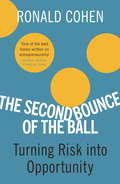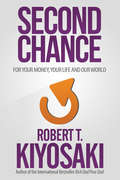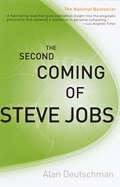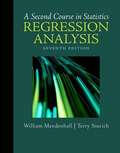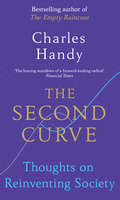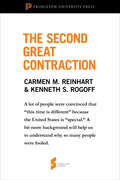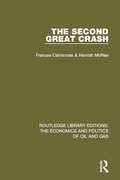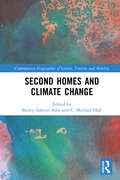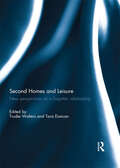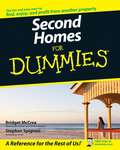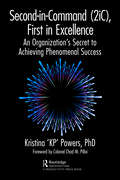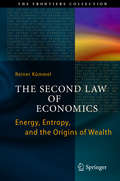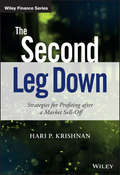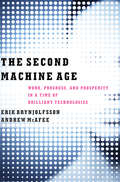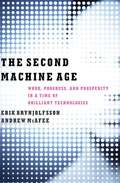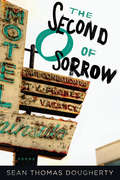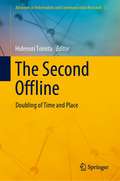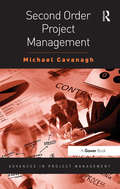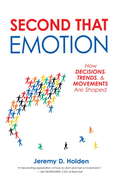- Table View
- List View
The Second Bounce Of The Ball: Turning Risk Into Opportunity
by Ronald CohenA unique insider's guide to turning risk into opportunityIn business, everyone can see the first bounce of the ball. It is the second bounce that is uncertain. Ronald Cohen, one of the world's leading private-equity investors, argues that the entrepreneur's aim is to take advantage of that uncertainty: for it is only in situations of uncertainty that significant gains can be made. Putting it another way, successful entrepreneurs know how to turn risk into opportunity.The book is essential reading for entrepreneurs, wannabe entrepreneurs and all those who want to apply entrepreneurial approaches in all walks of life. It provides relevant background on the development of entrepreneurship and of the venture-capital and private-equity industry through the prism of Cohen's experience at Apax. It provides guidance about how to take advantage of business opportunity: the right people and the right money and the roles played by personality and luck and underlines the importance of ethics.
The Second Bounce Of The Ball: Turning Risk Into Opportunity
by Sir Sir Ronald Cohen'One of the best books written on entrepreneurship in recent years' FINANCIAL TIMES In business, everyone can see the first bounce of the ball. It is the second bounce that is uncertain. Ronald Cohen, one of the world's leading private-equity investors, argues that the entrepreneur's aim is to take advantage of that uncertainty: for it is only in situations of uncertainty that significant gains can be made. Putting it another way, successful entrepreneurs know how to turn risk into opportunity.The book is essential reading for entrepreneurs, wannabe entrepreneurs and all those who want to apply entrepreneurial approaches in all walks of life. It provides relevant background on the development of entrepreneurship and of the venture-capital and private-equity industry through the prism of Cohen's experience at Apax. It provides guidance about how to take advantage of business opportunity: the right people and the right money and the roles played by personality and luck and underlines the importance of ethics.
Second Captain First Choose: How to Create a Support Network and Get the Feedback You Need to Grow, Change, and Succeed
by Thomas J. DelongToo many high-need-for-achievement professionals think that they can't ask anyone for help if they're struggling. They need to come across as tough and independent, never "soft" or uncertain. If this sounds like you, you could become isolated and less open to growth and change--and therefore less and less effective. In this chapter, leadership expert Thomas DeLong argues that if you want to overcome your fears and gain the courage to stretch yourself--both as a person and as a professional--you need a support network made up of people who will give you honest, useful, timely advice and feedback. After explaining how to choose respected others who will tell you the truth in a supportive way, DeLong introduces SKS--"Stop doing, Keep doing, Start doing"--as a simple, highly effective tool for eliciting actionable feedback. Vivid personal examples, along with suggestions you can put into practice today, will start you on your way to forming a support network that will make you a stronger and more successful leader. This chapter was originally published as Chapter 11 of "Flying Without a Net: Turn Fear of Change into Fuel for Success."
Second Chance: for Your Money, Your Life and Our World
by Robert T. KiyosakiFew would argue with the fact that, on many fronts, we are a world in crisis. And there are two sides to every crisis, be it a leadership crisis, an economic crisis, an education crisis or a moral crisis. The two side to crisis are danger and opportunity.Robert Kiyosaki's new book, Second Chance...for Your Money and Your Life, uses the lessons from the past and a brutal assessment of the present to prepare readers to see--and seize--the future.If readers can train their minds to see what their eyes cannot, in a world that is becoming increasingly more 'invisible' and moving at a high rate of speed, they can have a second chance at creating the life they've always wanted.The global problems we face cannot be solved by the same minds and people who created them and today's world demands the ability to see the future and prepare for what lies ahead...prepare for the opportunities as well as the challenges.Like it or not, we are all involved in the greatest evolutionary event in human history. The Industrial Age is over and the Information Age continues to accelerate. The visible agents of change have become invisible...and harder to see. And the future belongs to those who can train their minds, use the past to see the future, and take the steps to create the positive change they want to see in their lives.Second Chance is a guide to understanding how the past will shape the future and how you can use Information Age tools and insights to create a fresh start. This book is a guide to facing head-on the dangers of the crises around us-and steps and tips for seizing the opportunities they present.
A Second Chance for Europe: Economic, Political and Legal Perspectives of the European Union
by Jo RitzenThis book calls upon us to rethink and reboot the European Union. The authors dissect the EU's many vulnerabilities: how some Member States are backsliding on the rule of law, freedom of the press, and control of corruption - and how globalization's 'discontents' are threatening the liberal international order. It examines the need for a common immigration policy; the need to rethink the unsustainable debt overhang of some Eurozone countries; and the need to use education to foster a European identity. Given the sum total of these vulnerabilities, the book argues, the EU may not survive beyond 2025 in its present form - that is, unless decisive action is taken. In turn, the book puts forward a number of workable solutions: a European economic model to secure full employment; a stronger European Court of Human Rights to counter systemic violations; a points-based immigration policy; clear exit options for the Eurozone; and an Open Education Area with a common second language. These solutions may reduce the number of EU countries, but would increase cohesion and overall survivability.
The Second City: the Future of 'Yes, and...'
by Francesca Gino Jeff HuizingaLeaders from The Second City, the legendary Improv comedy company, reflect on its broad portfolio of activities through the lens of future opportunities and growth. In particular, they discuss ways in which Second City can further invest in its professional arm, Second City Works, and help workplaces embrace some of the main ideas of improv comedy to improve conversations, presence and collaboration.
The Second Coming of Steve Jobs
by Alan DeutschmanFrom the acclaimed Vanity Fair and GQ journalist--an unprecedented, in-depth portrait of the man whose return to Apple precipitated one of the biggest turnarounds in business history. From the emergence of Apple Computer in the late 1970s and early 1980s to its current resurgence, charismatic leader Steve Jobs has captivated the public. Both revered and reviled for his dictatorial manner and stunning successes, Jobs has transcended his legend in Silicon Valley to take on some of the heaviest hitters in Hollywood. Now, in The Second Coming of Steve Jobs, Alan Deutschman presents the most revealing portrait yet of this fascinating, complex character--an in-depth look at the many layers of Steve Jobs, a man who is at turns a brilliant cult figure and an abusive, egomaniacal kid. This story begins back in 1985 when Jobs was exiled from Apple, and then it goes on to chronicle the rise and fall of his own company, NeXT; the enormous success of Jobs's film animation studio, Pixar; and finally his triumphant return to Apple in the late 1990s, with Jobs taking the title of CEO in January 2000. Displaying an uncanny skill at the negotiation table and an intuitive sense of brilliant design that could capture the public's fascination with products like the iMac, along with a celebrity's ability to command the spotlight, Jobs has been able to catapult himself to the top of the Silicon Valley and Hollywood establishments. Based on interviews with scores of people--rivals, colleagues, friends--who have worked with Jobs over the years, The Second Coming of Steve Jobs gets under the hood of this extraordinarily complex man: how and why he almost gave up on his career; the details of his negotiations with Disney's Jeffrey Katzenberg and Michael Eisner, and of the culture clash between Silicon Valley and Hollywood; his methods of leadership, management, creativity, and innovation; his friendship and rivalry with Bill Gates--and much more. In an unsentimental and powerful voice, Deutschman reveals a man who suffered his midlife crisis at thirty, compressing it into just three months; struggled between self-imposed exile and the allure of public life; and became the baby boomer icon who was constantly blurring the lines between businessman, rock star, and beatnik. The Second Coming of Steve Jobs is a compelling look at an individual who has changed the face of technology and entertainment for the twenty-first century. This candid account of Steve Jobs's tumultuous and provocative career will answer the many questions left unanswered by this incredibly private character who has come to represent the Silicon Valley American dream.
A Second Course In Statistics: Regression Analysis
by Terry Sincich William MendenhallA Second Course in Statistics: Regression Analysis, Seventh Edition, focuses on building linear statistical models and developing skills for implementing regression analysis in real situations. This text offers applications for engineering, sociology, psychology, science, and business. The authors use real data and scenarios extracted from news articles, journals, and actual consulting problems to show how to apply the concepts. In addition, seven case studies, now located throughout the text after applicable chapters, invite readers to focus on specific problems.
The Second Curve: Thoughts on Reinventing Society
by Charles HandyBritain's leading guru looks to the future.Charles Handy is one of the giants of contemporary thought. His books on management – including Understanding Organizations and Gods of Management – have changed the way we view business. His work on broader issues and trends – such as Beyond Certainty – has changed the way we view society. In The Second Curve, Handy builds on a life's work to glimpse into the future and see what challenges and opportunities lie ahead. He looks at current trends in capitalism and asks whether it is a sustainable system. He explores the dangers of a society built on credit. He challenges the myth that remorseless growth is essential. He even asks whether we should rethink our roles in life – as students, parents, workers and voters – and what the aims of an ideal society of the future should be. Provocative and thoughtful as ever, he sets out the questions we all need to ask ourselves – and points us in the direction of some of the answers.
The Second Great Contraction: From This Time Is Different (Princeton Shorts #6)
by Carmen M. Reinhart Kenneth S. RogoffWe've been assured that the recession is over, but the country and the economy continue to feel the effects of the 2008 financial crisis, and people are still searching for answers about what caused it, what it has wrought, and how we can recover. This selection from the best-selling book This Time Is Different—the definitive history of financial crises, including the recent subprime meltdown—answers these questions and more.Princeton Shorts are brief selections excerpted from influential Princeton University Press publications produced exclusively in eBook format. They are selected with the firm belief that while the original work remains an important and enduring product, sometimes we can all benefit from a quick take on a topic worthy of a longer book.In a world where every second counts, how better to stay up-to speed on current events and digest the kernels of wisdom found in the great works of the past? Princeton Shorts enables you to be an instant expert in a world where information is everywhere but quality is at a premium. The Second Great Contraction does just that.
The Second Great Crash (Routledge Library Editions: The Economics and Politics of Oil and Gas #1)
by Frances Cairncross Hamish McRaeUsing highly-readable, non-technical language, the authors, both professional economists, describe all the major global economic forces at work in the 1970s and forecast the kind of future which such forces are creating (and which has indeed been the case). Inflation and recession, an energy crisis, international monetary disorder and a food crisis in the developing world are all discussed.
Second-Hand Luxus in Deutschland: Eine multidimensionale Erfassung des Kaufverhaltens (BestMasters)
by Pirie GrützmacherJeder zehnte persönliche Luxusartikel wird mittlerweile gebraucht gekauft. Dennoch sind Untersuchungen in diesem Segment bislang rar. Pirie Grützmacher untersucht anhand einer Befragung unter 418 Käufern von gebrauchten persönlichen Luxusartikeln erstmals das Kaufverhalten im High End Second-Hand-Segment in Deutschland. Dabei wird ein breites Spektrum der konsumrelevanten Entscheidungsprozesse in der Vorkauf-, Kauf- und Konsum-/Nachkaufphase dargestellt. Auch mögliche geschlechts- und altersgruppenspezifische Unterschiede werden untersucht. Die Ergebnisse der Studie weisen auf ein enormes Wachstumspotential des High End Second-Hand Segments hin. Dies korrespondiert mit einer sich fundamental wandelnden Haltung der Luxuskunden. So zeigt die Studie dynamische Veränderungen auf, die den gesamten Luxusmarkt beeinflussen können.
Second Harvest Heartland: Ending Hunger Together
by V. Kasturi Rangan Courtney HanIn March 2020, Second Harvest Heartland, one of six Foodbanks serving Minnesota, was caught in the COVID-19 emergency with considerably more people exposed to hunger and food insecurity. Its management team led by CEO Allison O' Toole and COO Theirry Ibri alertly managed the crisis by improvising and implementing new programs. In August 2021, with signs of the crisis behind them, they had to decide which of the adaptations they should keep, and how to go back to addressing their original mission of ending hunger.
Second Homes and Climate Change (Contemporary Geographies of Leisure, Tourism and Mobility)
by Bailey Ashton Adie C. Michael HallThis book is the first to address the important interrelationship between second homes and climate change, which has become an increasingly relevant issue for many regions around the world. Second homes are often a key source of tourist visitation as well as economic benefit for their host communities. The chapters provide an array of international case studies and climate change impacts, including the changing biocultural landscapes in Italy, hazard risks in the mountains of Poland, and the shifting media discussion on second homes and climate change in Finland. Topics covered focus on issues around planning and governance in second home locations, adaptation and mitigation measures implemented by second home owners, and the influence of second home owners’ place attachment in relation to second home impacts. It introduces the overall topic of second homes and climate change while also laying the groundwork for future work in this burgeoning area of research. This book will be of significant interest to upper-level undergraduates, graduate students, and academics in the fields of geography, tourism, planning, housing studies, regional development, environmental management, and disaster management. It would also be of use for professionals who engage with second home communities, particularly planners, government officials, and environmental officers.
Second Homes and Leisure: New perspectives on a forgotten relationship
by Trudie Walters and Tara DuncanSecond homes (variously summer houses, shacks, baches, cottages, dacha) are a popular cultural phenomenon in many countries and an emerging trend in others. They are inextricably linked to tourism, recreation and leisure, and yet the fundamental relationship between second homes and leisure often appears to have been overlooked by researchers in the area. This book seeks to address this absence, bringing together an exciting collection of research from around the world. Drawing on examples from Canada, Japan, Morocco, Costa Rica, New Zealand and the United Kingdom, this book highlights the interdisciplinary nature of second home research in the leisure field. The book describes the nexus of second homes and leisure from a variety of perspectives: planning and policy, historical, social and cultural. It is an essential work for those interested in new cultural viewpoints on second homes and leisure practices. This book was originally published as a special issue of Annals of Leisure Research.
Second Homes for Dummies
by Bridget Mccrea Stephen SpignesiThinking about owning a second home? Whether you want a relaxing getaway spot, a future retirement home, or just a place to rent out for profit, having a second home has always been a good investment. But how will you know where to look, how to invest, and what you need to avoid? Second Homes For Dummies gives you the tools you need to handle the entire second-home buying process from concept to completion! This book covers the bases and the basics of buying a second home, presenting all information in a logical and modular format so you can find just what you need on the subjects that interest you. You'll find out everything you need to know to: Determine whether or not a second home is right for you Maximize your options for a second home Search for a home and find the money to pay for it Rent out your home for profit Renovate and maintain it to ensure its growing value Make your second home your primary home Look for and purchase a home in another country Also provided are a list of the best places in the world to buy a home, ways to improve your home and make it first rate, and rules that you should talk about with your guests. With Second Homes For Dummies, you can make your dream of having a second home come true!
Second-in-Command (2iC), First in Excellence: An Organization's Secret to Achieving Phenomenal Success
by Kristina 'KP' Powers, PhDWhy do some departments, divisions, and organizations soar while others struggle? Watching another team achieve the success you feel yours more rightfully deserves can be incredibly frustrating. However, they might have something you don’t: Seconds-in-Command. Given how many Seconds-in-Command exist in the workforce, it is stunning that there are so few books about them. Organizations can and often do have more than one 2iC; large ones may have hundreds. KP Powers focuses on essential skills that individuals in these positions already possess and can enhance to become an organization’s key to achieving phenomenal success. This book introduces the groundbreaking concept of linking multiple 2iCs to form a Second-in-Command chain. This game-changing technique increases the positive impact that 2iCs can have on organizational and leader success. In today’s world, leaders no longer have the luxury of hiring more people to keep up with a growing workload. The labor shortage and the need to cut costs because of looming economic issues make that impractical. It makes more sense to consider a new organizational framework that includes 2iCs, thus multiplying existing team members’ contributions. This is especially critical in highly regulated fields such as higher education, finance, and health care, where the stakes and penalties are high and unforgiving. Second-in-Command, First in Excellence invites readers to think differently about this critical role. Geared toward leaders who have or want a 2iC as well as 2iCs themselves, this book both demonstrates the value of the 2iC position and serves as a tool for professional development.
The Second Law of Economics
by Reiner KümmelNothing happens in the world without energy conversion and entropy production. These fundamental natural laws are familiar to most of us when applied to the evolution of stars, biological processes, or the working of an internal combustion engine, but what about industrial economies and wealth production, or their constant companion, pollution? Does economics conform to the First and the Second Law of Thermodynamics? In this important book, Reiner Kümmel takes us on a fascinating tour of these laws and their influence on natural, technological, and social evolution. Analyzing economic growth in Germany, Japan, and the United States in light of technological constraints on capital, labor, and energy, Professor Kümmel upends conventional economic wisdom by showing that the productive power of energy far outweighs its small share of costs, while for labor just the opposite is true. Wealth creation by energy conversion is accompanied and limited by polluting emissions that are coupled to entropy production. These facts constitute the Second Law of Economics. They take on unprecedented importance in a world that is facing peak oil, debt-driven economic turmoil, and threats from pollution and climate change. They complement the First Law of Economics: Wealth is allocated on markets, and the legal framework determines the outcome. By applying the First and Second Law we understand the true origins of wealth production, the issues that imperil the goal of sustainable development, and the technological options that are compatible both with this goal and with natural laws. The critical role of energy and entropy in the productive sectors of the economy must be realized if we are to create a road map that avoids a Dark Age of shrinking natural resources, environmental degradation, and increasing social tensions.
The Second Leg Down: Strategies for Profiting after a Market Sell-Off
by Hari P. KrishnanCut risk and generate profit even after the market drops The Second Leg Down offers practical approaches to profiting after a market event. Written by a specialist in global macro, volatility and hedging overlay strategies, this book provides in-depth insight into surviving in a volatile environment. Historical back tests and scenario diagrams illustrate a variety of strategies for offsetting portfolio risks with after-the-fact options hedging, and the discussion explores how a mixture of trend following and contrarian futures strategies can be beneficial. Without a rational analysis-based approach, investors often find themselves having to cut risk and buy protection just as options are at their most over-priced. This book provides practical strategies, expert analysis and the knowledge base to assist you in recovering your portfolio. Hedging strategies are often presented as expensive and unnecessary, especially during a bull market. When equity indices and other unstable assets drop, they find themselves stuck – hedging is now at its most expensive, but it is imperative to hedge or face liquidation. This book shows you how to salvage the situation, with strategies backed by expert analysis. Identify the right hedges during high volatility Generate attractive risk-adjusted returns Learn new strategies for offsetting risk Know your options for when losses have already occurred Imagine this scenario: you've incurred significant losses, you're approaching risk limits, you must cut risk immediately, yet slashing positions would damage the portfolio – what do you do? The Second Leg Down is your emergency hotline, with practical strategies for dire conditions.
The Second Machine Age: Work, Progress, And Prosperity In A Time Of Brilliant Technologies
by Erik Brynjolfsson Andrew McafeeA New York Times Bestseller A revolution is under way. In recent years, Google's autonomous cars have logged thousands of miles on American highways and IBM's Watson trounced the best human Jeopardy! players. Digital technologies--with hardware, software, and networks at their core--will in the near future diagnose diseases more accurately than doctors can, apply enormous data sets to transform retailing, and accomplish many tasks once considered uniquely human. In The Second Machine Age MIT's Erik Brynjolfsson and Andrew McAfee--two thinkers at the forefront of their field--reveal the forces driving the reinvention of our lives and our economy. As the full impact of digital technologies is felt, we will realize immense bounty in the form of dazzling personal technology, advanced infrastructure, and near-boundless access to the cultural items that enrich our lives. Amid this bounty will also be wrenching change. Professions of all kinds--from lawyers to truck drivers--will be forever upended. Companies will be forced to transform or die. Recent economic indicators reflect this shift: fewer people are working, and wages are falling even as productivity and profits soar. Drawing on years of research and up-to-the-minute trends, Brynjolfsson and McAfee identify the best strategies for survival and offer a new path to prosperity. These include revamping education so that it prepares people for the next economy instead of the last one, designing new collaborations that pair brute processing power with human ingenuity, and embracing policies that make sense in a radically transformed landscape. A fundamentally optimistic book, The Second Machine Age will alter how we think about issues of technological, societal, and economic progress.
The Second Machine Age: Work, Progress, and Prosperity in a Time of Brilliant Technologies
by Erik Brynjolfsson Andrew McafeeA revolution is under way.<P> In recent years, Google’s autonomous cars have logged thousands of miles on American highways and IBM’s Watson trounced the best human Jeopardy! players. Digital technologies—with hardware, software, and networks at their core—will in the near future diagnose diseases more accurately than doctors can, apply enormous data sets to transform retailing, and accomplish many tasks once considered uniquely human.<P> In The Second Machine Age MIT’s Erik Brynjolfsson and Andrew McAfee—two thinkers at the forefront of their field—reveal the forces driving the reinvention of our lives and our economy. As the full impact of digital technologies is felt, we will realize immense bounty in the form of dazzling personal technology, advanced infrastructure, and near-boundless access to the cultural items that enrich our lives.<P> Amid this bounty will also be wrenching change. Professions of all kinds—from lawyers to truck drivers—will be forever upended. Companies will be forced to transform or die. Recent economic indicators reflect this shift: fewer people are working, and wages are falling even as productivity and profits soar.<P> Drawing on years of research and up-to-the-minute trends, Brynjolfsson and McAfee identify the best strategies for survival and offer a new path to prosperity. These include revamping education so that it prepares people for the next economy instead of the last one, designing new collaborations that pair brute processing power with human ingenuity, and embracing policies that make sense in a radically transformed landscape.<P> A fundamentally optimistic book, The Second Machine Age will alter how we think about issues of technological, societal, and economic progress.
The Second O of Sorrow (American Poets Continuum Series #165)
by Sean Thomas DoughertySean Thomas Dougherty celebrates the struggles, the dignity, and the joys of working-class life in the Rust Belt. Finding delight in everyday moments—a night at a packed karaoke bar, a father and daughter planting a garden, a biography of LeBron James as a metaphor for Ohio—these poems take pride in the people who survive despite all odds, who keep going without any concern for glory, fighting with wit and grace for justice, for joy, every god damned day.
The Second Offline: Doubling of Time and Place (Advances in Information and Communication Research #3)
by Hidenori TomitaThis book presents current research on mobile Internet society. Past research was not able to show a clear analytical framework, thus was unable to close in on the fundamental changes in that society. This book, however, analyzes mobile Internet society by introducing the concept of “doubling of time and place” and the analytical framework of the “second offline.” The emergence of the smartphone has made Internet use easier, and now, people are constantly using online information in the midst of their daily lives. Our society is transitioning from the first offline society, a society without being connected to Internet, to the second offline society, where users are connected to the Internet at all times. In this second offline society, our sense of time and place are beginning to change. Broadcast and communication media have made possible the overlapping of different places, which has been called the doubling of place. Furthermore, virtual reality (VR) and augmented reality (AR) technologies have enabled the overlap of different times, which this book calls the doubling of time. The smartphone makes both possible. With the second offline and the doubling of time and place as keywords, the book takes into consideration research that includes, among other topics, the media usage of young adults, selfies, education, social media usage, mobile games, work stations, and consumer activity in the mobile Internet society.
Second Order Project Management (Advances in Project Management)
by Michael CavanaghIf you do what you've always done, you'll get what you've always got, and if it's not good enough, you need to do something else. As project complexity increases, so too does the need to do new things. The existing Project Management tools - examples being Earned Value Management, PRINCE2, Lifecycle Management, PMBOK® - are incredibly useful; but they were designed for linear project development in a stable, understood environment. We term them 'First Order'. Second Order Project Management (PM) goes beyond, addressing the issues of a complex, unstable, uncertain environment with all its associated difficulties. Second Order PM has to address four major issues: the conspiracy of optimism, inappropriate contracting models, the application of methods and tools capable of dealing with complexity, and the need for creative, inspirational, adhocratic leadership. These problems are compounded by the need to convince executive sponsors from different disciplines to invest in the necessary process improvement - this book is designed to help alleviate the frustration that every member of the profession has experienced when trying to gain such approval. Illustrated by interviews with an international group of very senior managers responsible for managing highly complex projects, Michael Cavanagh explains why there is nothing magical, or even complicated, about Second Order PM. The techniques discussed include aspects of System Thinking, Experiential Learning and its application, Ethics and Governance, Stakeholder Relationships, Appropriate Contracting Models, Outcome-driven Management and Leadership Behaviour, all recognised as increasingly necessary in direct proportion to the complexity of the project at hand.
Second That Emotion
by Jeremy D. HoldenFor businesspeople who want to see their company or brand break through, this book is both essential and entertaining reading. For the rest of us, the author provides a window into our decision-making processes, and how emotion-based illogical leaps drive our support for movements, whether they are political, commercial, or related to popular culture. Why do more than 30 percent of Americans believe President Obama is a Muslim? Why do most fans who supported Dove®'s "campaign for real beauty" feel comfortable ignoring the fact that the brand's parent company, Unilever, was also behind the Axe® campaign, a brand that has blatantly stereotyped women? Why is Yoko Ono still held responsible for the breakup of the Beatles? These and other random, yet related, questions are explained in here. An advertising and communications expert traces the fascinating process whereby a passion for an idea, a politician, a celebrity, or a brand gives rise to a set of illogical beliefs that becomes the basis for a powerful movement. Conventional wisdom has it that spin doctors and Madison Avenue are responsible for manipulating our thoughts, causing us to endorse ideas or buy products that we would otherwise reject outright. Holden shows that while advertising and propaganda can provide a spark and social media provides the kindling, individuals create consumer, political, and cultural trends based, more often than not, on thinking that they know logically to be flawed.
